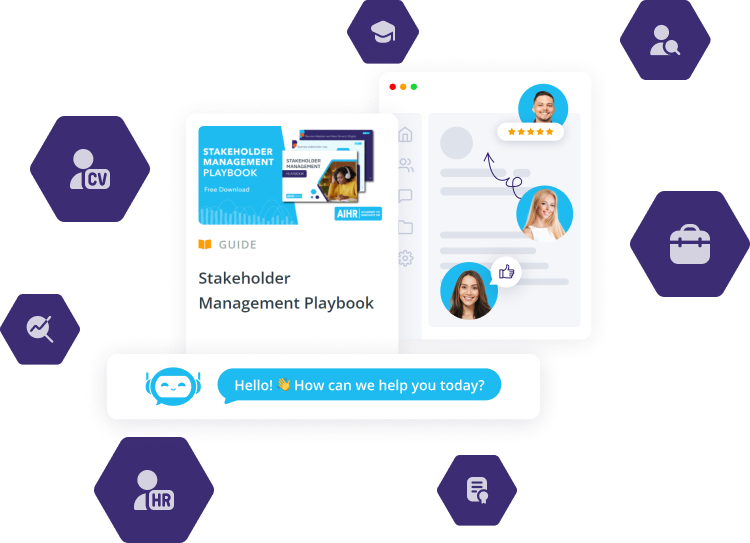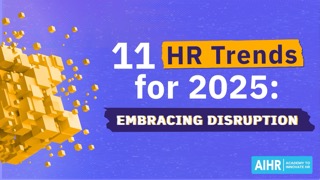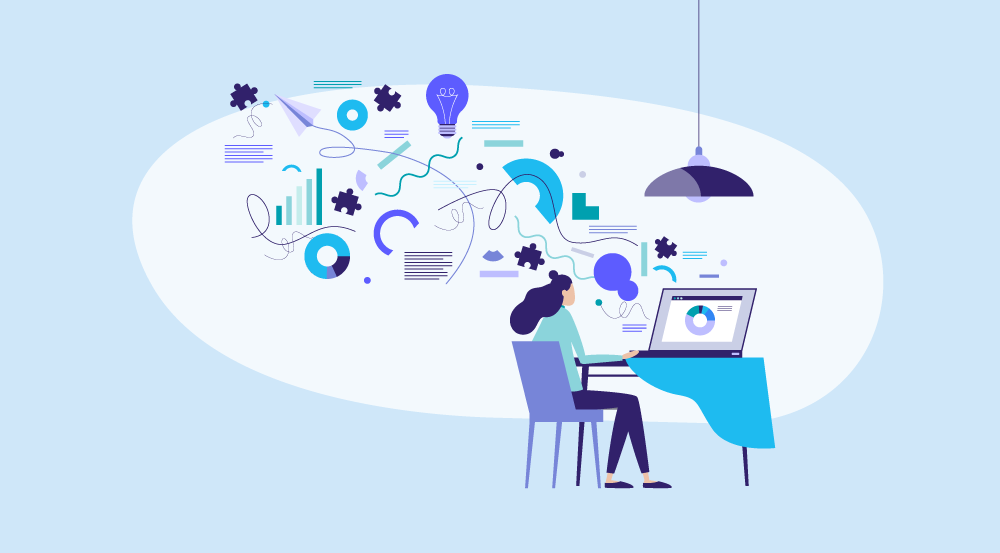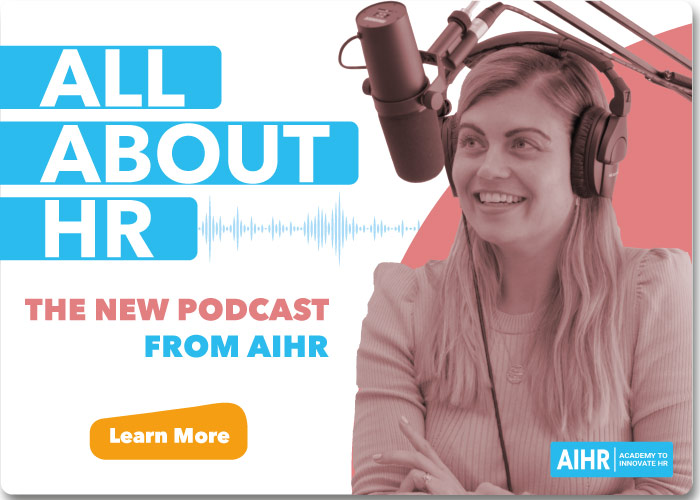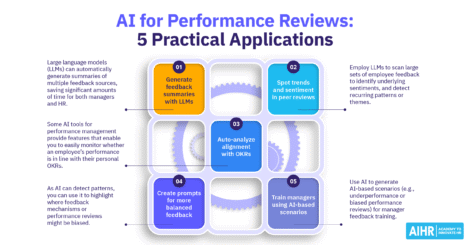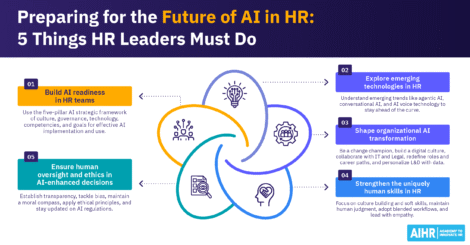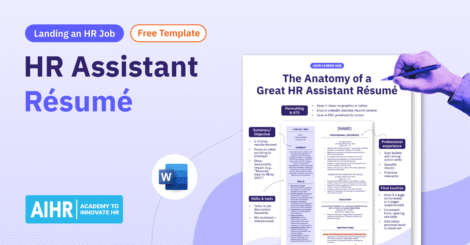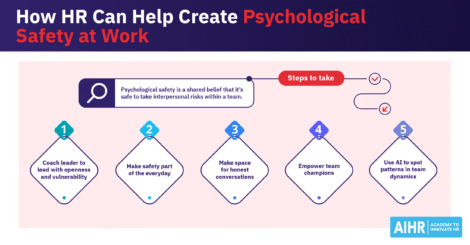AI in HR has moved far beyond basic automation. In fact, 77% of AI users say it helps them get more done faster, and 73% say it improves work quality. AI is now blending human judgment with machine efficiency to boost productivity and personalization.
For HR leaders, the message is clear: get on board or get left behind. But it’s important to remember that AI should support HR — not replace it. This article explores key adoption areas, the barriers to adoption, and how you can ensure success in AI adoption for HR.
Contents
Key areas for adoption of AI in HR
Additional AI applications in HR
Barriers to AI adoption in HR
7 best practices for the successful adoption of AI in HR
FAQ
Key takeaways
- AI is already transforming HR by boosting efficiency, personalizing employee experiences, and supporting better decision-making
- Recruitment, employee self-service, and L&D are leading the way in AI adoption, with more advanced, autonomous tools on the rise
- Common barriers include low AI literacy, limited focus on strategic use, and lack of clear success metrics
- Successful adoption requires aligning AI with business goals, training HR teams, starting with low-risk tools, and tracking impact.
Key areas for adoption of AI in HR
Below are some key areas for the adoption of AI in HR to consider:
Recruitment
Recruitment was the first HR function to embrace AI, focusing on automating tasks like résumé-screening, writing job descriptions, and using predictive analytics to shortlist top candidates. This frees recruiters to focus on branding, interviews, and candidate evaluations.
The next phase involves agentic AI, which can manage multi-step tasks like first-round interviews, scheduling, and feedback. Voice analysis can evaluate tone and hesitation to assess communication skills. Interview bots now adjust questions in real-time, making the process feel more natural.
Employee self-service
AI is changing employee support from ticket-based systems to 24/7 self-service. Chatbots handle common questions, leave requests, and admin tasks like updating personal info. They work right inside tools like Slack or Teams.
Next-gen AI will go further. It will anticipate needs—like reminding staff of training deadlines based on their roles—using agentic systems that can handle entire workflows. This results in employees getting instant support, and HR teams gaining time to focus on strategic work like engagement and conflict resolution.
Learning & development (L&D)
AI can now analyze an employee’s performance data, career aspirations, and current skill set to recommend relevant training resources. It can then curate content from various sources to create hyper-personalized and goal-oriented learning paths, and ‘nudge’ employees with reminders and encouragement to stay on track.
More advanced tools can even simulate real-life scenarios to help employees practice difficult skills. Some examples include tough customer calls or sales negotiations. AI can also analyze your entire workforce to identify where you have existing skills and potential gaps, and match employees with suitable mentors.
Additional AI applications in HR
Other impactful use cases for AI in HR include:
- Workforce planning: AI can use internal and market data to help predict attrition and skills gaps, supporting talent pipelines and retention efforts.
- Onboarding and offboarding: AI automates onboarding journeys based on role and department. It guides new hires, connects them to colleagues, and handles admin. It also streamlines offboarding and collects valuable exit data.
- Analytics for talent, DEIB, and compliance: AI can spot patterns in engagement, attrition, and compliance issues. It helps improve DEIB by highlighting inequalities and supports better decision-making across HR.
Barriers to AI adoption in HR
Despite many clear benefits, the adoption of AI in HR is not without its hurdles. These barriers extend beyond technical complexities and can slow implementation and strategic impact:
Competence and confidence gaps
There’s a significant gap between the application of AI in HR and the skills needed to use it effectively. While 82% of HR professionals are using AI, less than a third have job-specific training. Without AI literacy, there’s hesitation, especially with advanced tools that handle complex tasks, as fear of mistakes can slow progress.
Overfocus on efficiency
HR often starts with quick wins—like automating job postings—without moving on to strategic uses like predictive workforce planning or tailored learning paths. An over-reliance on simple task automation can prevent HR from realizing AI’s full potential to drive significant business value and further improve the HR function.
Lack of clear success metrics
Another significant barrier to AI adoption in HR is the difficulty in proving its business value. Unlike other metrics-driven departments, like sales or finance, HR metrics are often less tangible. If results aren’t tied to clear goals like better retention or engagement, leaders may hesitate to justify further investment, delaying the adoption of more advanced AI solutions.
To maximize the adoption of AI to propel your HR function forward, you must focus on practical implementation, upskill your team, align initiatives with business goals, and ensure ongoing monitoring for fairness and effectiveness.
With AIHR’s AI for HR Boot Camp, your team will:
✅ Build a clear understanding of emerging AI tools and how they work in HR contexts
✅ Work on practical projects, using generative AI to improve HR workflows
✅ Learn how to lead AI adoption responsibly, and align AI initiatives with HR strategy
🎯 Turn early adoption into long-term impact with a team fluent in AI.
7 best practices for the successful adoption of AI in HR
Follow these guidelines to overcome AI adoption barriers and ensure successful and ethical implementation in your HR function:
1. Build AI readiness in your HR team
Build AI skills across your team. Teach tool usage, bias detection, governance, and how to interpret results. Use an AI strategy framework that covers the five pillars of culture, governance, technology, skills, and goals. Additionally, be sure to offer workshops and courses, and appoint a suitable AI lead.
2. Foster a culture of continuous innovation and learning
AI is evolving at a pace, which means your HR team must evolve along with it to keep up. Encourage experimentation in safe environments, and foster a culture where testing new tools — and failing — is okay. Recognize and reward team members who learn from failure and improve, and share AI insights to boost adoption.
3. Implement AI in low-risk areas first
Start with simple, low-stakes applications that provide quick wins and build confidence. Automating administrative tasks with a chatbot is a good starting point for entry-level users. This will give your team the practical experience needed to use AI to tackle more complex, strategic projects later on.
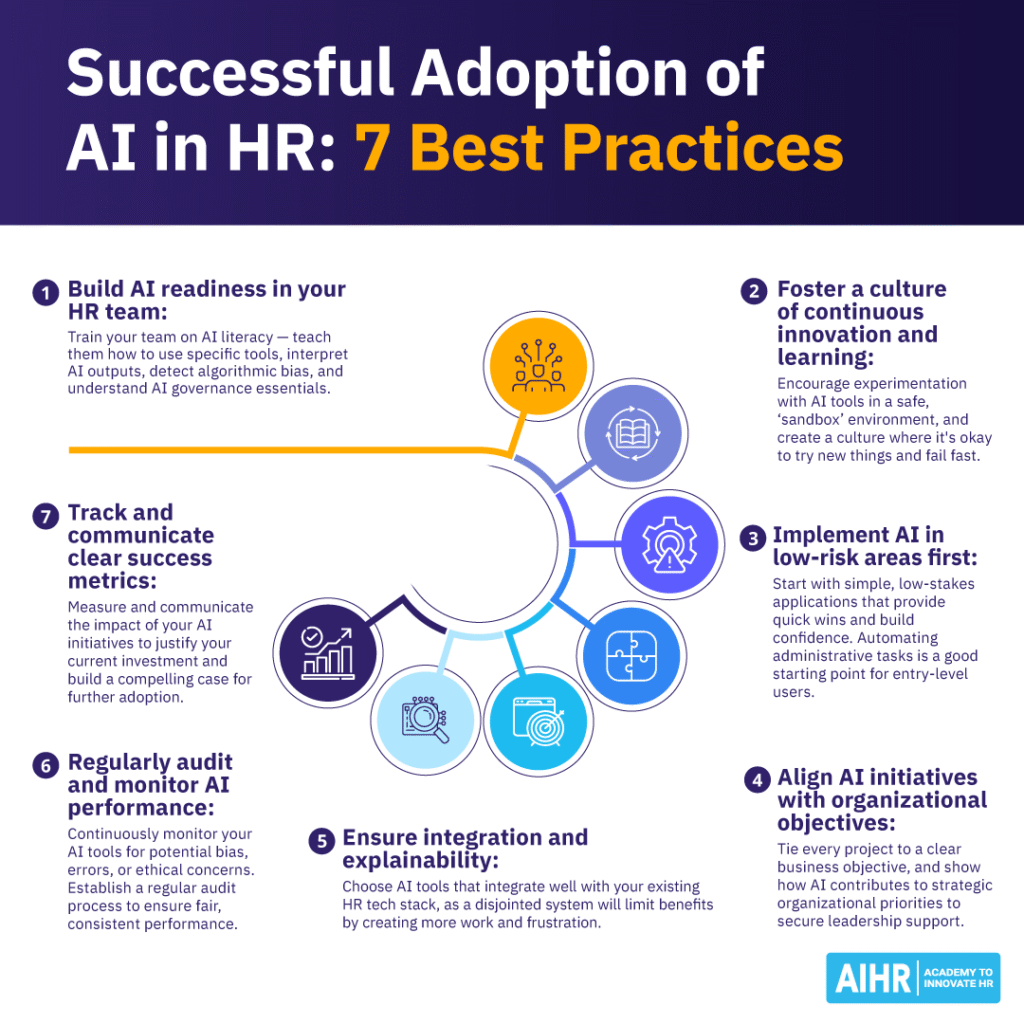
4. Align AI initiatives with organizational objectives
Never implement AI just for the sake of implementing AI. Instead, tie each AI project to a business goal. Set HR SMART goals — instead of “use AI for recruiting”, aim for something specific like “cut time to hire by 25% using AI résumé-screening by Q3”. At the same time, link projects to KPIs and involve leadership early.
5. Ensure integration and explainability
Choose AI tools that integrate well with your existing HR tech stack. A disjointed system will limit benefits by creating more work and frustration. Additionally, make sure the AI’s decisions are transparent, and keep humans in the loop — especially for major people decisions. This is key to building and maintaining trust.
6. Regularly audit and monitor AI performance and fairness
Ongoing vigilance is necessary for responsible AI use, so continuously monitor your AI tools for potential bias, errors, or ethical concerns. Establish a regular audit process to ensure consistent AI performance aligned with organizational values, and make sure results are fair across all demographics.
7. Track and communicate clear success metrics
Measure and communicate AI’s impact at your company to justify current investment and encourage further adoption. Track and report on efficiency gains, hiring quality, engagement, and retention. Then, share clear outcomes with senior leadership to build their confidence in AI and highlight HR’s strategic value.
Final thoughts
The journey toward widespread adoption of AI in HR is inevitable, setting the stage for AI to become an indispensable tool for HR professionals. HR leaders who are quick to embrace this partnership will be best positioned to lead their organizations forward and contribute to building greater competitive advantage.
To fully realize these benefits, HR teams must focus on building AI skills, aligning tools with business goals, and measuring outcomes that matter. This means starting with practical use cases, ensuring ethical oversight, and fostering a culture of continuous learning and innovation.
FAQ
• Collaboration: Work with IT and Legal to ensure smooth, ethical AI use.
• Change management: Communicate benefits, reduce fear, and provide training.
• Talent strategy: Create and hire for AI-related roles.
• HR transformation: Use AI in recruitment, planning, and DEIB to boost impact.
• Ethics: Maintain fairness and trust through transparency and oversight.
• Growing use of generative AI for job descriptions and outreach
• Personalized learning paths and development plans at scale
• Predictive analytics for managing attrition, compensation, and talent
• DEIB tracking to ensure fair hiring and promotions
• Rise of agentic AI for complex workflows like recruitment and onboarding.


